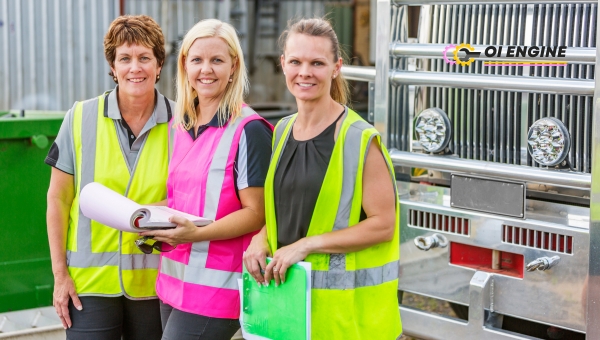Have you ever thought about what it’s like to spend your days on the open road, with the horizon as your guide and a sense of freedom at every turn? Well, more and more women are steering towards careers in trucking, turning this once male-dominated world into a place where diversity is gaining speed!
Women in Trucking isn’t just a movement; it’s an inspiring tale of empowerment that’s taking the highway by storm. Who would have guessed that rig trucks could spark such change?
In the past 20 years, the number of women working as truckers has not just grown — it’s downright doubled! What was once seen as uncharted territory for women is now becoming a landscape filled with opportunities.
Despite facing challenges like gender bias and balancing work with personal life, these trailblazing ladies are proving they can handle big rigs just as well as men. It’s not just about claiming space; it’s about redefining an industry.
The Rise of Women in Trucking
The trucking industry, for many years, was dominated by men. However, over the past 20 years, a significant shift has been observed.

There’s been a noticeable rise in the number of women engaging and excelling in trucking jobs. So what influenced this marked increase? Let’s delve into it.
Understanding the Driving Force
A combination of factors played a pivotal role in increasing women’s participation in this industry. Here are some key reasons behind their heightened interest:
- Higher Pay Scale: Historically speaking, truck driving jobs are well compensated compared to many other occupations requiring similar skills and qualifications. The chance to earn an attractive salary was inviting for many women.
- Economic Necessity: Many women found themselves as solo breadwinners due to various personal circumstances and chose trucking as it provided lucrative employment opportunities.
- Flexible Working Hours: Unlike the general perception that one needs to be away from home for extended periods while working as a driver, some truck companies provide flexibility that allows drivers to work regionally or locally and afford them more home time.
- Non-Discriminatory Occupation: Truck driving is fundamentally about ability rather than gender; excellent driving is rewarded regardless if you’re male or female.
- Job Availability: Given that there is usually a shortage of qualified truck drivers in the employment market; job security was another deciding factor influencing more women to join this field.
Statistics and Trends
In the last two decades, female representation in trucking has seen a remarkable ascent. This trend is evident when you look at the statistical data that distinctly depicts their impressive progress.
A recent report by the American Trucking Association (ATA) shows quite clearly that there’s been a twofold increase in the number of women taking on trucking jobs over the past 20 years.
In fact, according to the Women in Trucking Association (WIT), women now comprise nearly 13.7% of over-the-road (OTR) truck drivers and about 17% of all transportation, storage, and distribution managers – which marks an impressive leap from only 3% twenty years ago.
This growth trend shows no signs of slowing down with more and more women being attracted to this industry for a variety of reasons.
Moreover, safety records reveal that female drivers are often safer than their male counterparts leading many employers in this sector keen to hire more women.
It’s clear from these trends and statistics that “women in trucking” is no longer a rarity but rather an established norm reshaping this traditionally male-dominated industry.
Also Read: Trailer Interchange Coverage-Protect Your Fleet!
Challenges Experienced by Women in Trucking
It’s important to recognize that while women in trucking have indeed made significant strides, a lot of obstacles still stand in their way.
These barriers are mostly due to gender bias and difficulties maintaining work-life balance, both significantly impacting the experience of women in this field. Let’s take a closer look.
Gender Bias
Unfortunately, gender bias remains a glaring issue within the trucking industry. Many people still hold onto the outdated belief that truck driving is a “man’s job.”
These biases often translate into practical hurdles for women trying to make their way into the field. For instance, they may encounter discrimination during hiring procedures or face skepticism about their driving abilities despite displaying equal competence.
Moreover, these perceptions create an unwelcoming work environment for many women. The lack of fellow female colleagues can lead to feelings of isolation and discomfort.
This form of bias serves as an unnecessary barrier for talented women who might otherwise succeed and enjoy their careers within this industry.
Work-Life Balance
Another challenge faced by women in trucking is achieving a healthy work-life balance. Truck driving often involves long hours on the road, leading to disruption of social life and family commitments back at home.
This aspect becomes even more pronounced for women with young children or dependent family members who require care.
Some companies are recognizing these challenges and implementing changes accordingly architect solutions that enable better work-life balance for female truck drivers.
Examples include offering flexible schedules or routes closer home or setting up childcare facilities at major stops would go a long way toward making this career more accessible and manageable for many women.
Balancing professional responsibility with personal commitment indeed requires effective management skills but it’s far from impossible – numerous successful cases underscore resilience shown by many dedicated strong-willed females associated with industry left no stone unturned juggling between professional duties & familial responsibilities effectively demonstrating it’s doable if one puts its heart & soul.
Embracing Diversity within the Trucking Industry
As an evolving field, the trucking industry has seen a tremendous shift on many fronts over recent decades. One of such noteworthy shifts is the embracement of diversity in its workforce, which now more than ever includes more women.

This paradigm shift not only upturns age-old stereotypes but also makes way for numerous benefits for both, employers and the female population opting for employment in this sector.
Benefits for Employers
An open-minded approach to hiring more women comes with a range of perks for firms operating within this industry. Five Key benefits they stand to gain include:
- Increased productivity – Studies have shown that women tend to be safer drivers compared to their male counterparts which directly translates into fewer road accidents and subsequently less downtime.
- Enhanced workforce diversity – More female employees naturally lead to diversified input as well as a broader range of ideas and perspectives which can be vastly beneficial from an operational viewpoint.
- Merited competitiveness – Having more skilled women in trucking builds into being competitive on merit rather than based on gender or physical capacities traditionally associated with men.
- Bigger talent pool – By encouraging Women’s participation, companies essentially double their prospective employee base leading them to be less dependent on limited resources.
- Improved corporate image – Companies employing higher numbers of females are often viewed as proponents of gender equality which boosts their public image.
Advantages for Women
For many women out there evaluating career options, delving into trucking may prove to be empowering beyond common perception. The following points encapsulate major advantages they stand to gain:
- Economic independence – With fair pay scales in place, driving can offer financial stability and freedom.
- Skill development – Truck driving offers a set of distinct skills including punctuality, navigational capabilities, and mechanical knowledge enriching one’s skillset further.
- Flexibility – Scheduling offers a certain degree of flexibility making it suitable for individuals who like being on the move.
- Room for growth – There is immense scope for growth as drivers can pursue further career advancements in logistics or transportation management.
- Breaking stereotypes – Choosing a career path, traditionally dominated by men can be extraordinarily empowering and uplifting in terms of personal achievement.
These key driving factors accentuate how embracing diversity within the Trucking Industry paves the way toward numerous mutual benefits.
This, in turn, reiterates that every gender brings its own set of strengths to the table. A well-rounded approach truly reaps wholesome results for everyone involved: individuals and corporations alike.
Also Read: Unlock Postal Productivity With Postage Meters
Facilitating Growth of Women in Trucking
Years of gender imbalance within the trucking industry have necessitated the need for strategic actions to foster more involvement and growth of women in trucking.

Today, this sector is experiencing a positive shift as organizations and government bodies are actively putting measures in place to encourage the increase of women truck drivers.
Initiatives Taken by Companies
Several organizations within the trucking industry have stepped forward, implementing creative initiatives to appeal to women and ensuring their often-unique needs are properly catered for:
- Equal Pay with Men: Some companies have adopted policies that ensure their female drivers earn just as much as their male counterparts. This is a significant stride bearing in mind that wage equality continues to be an issue across various sectors globally.
- Flexible Work Hours: Recognizing that women frequently wear many hats – juggling family responsibilities alongside work commitments, several corporations now offer flexible hours for their female employees.
- Training Programs: Understanding that confidence at the wheel can significantly influence job performance, leading companies have tailored training programs specifically targeting women. These workshops focus on basic skills but also tackle challenges unique to females within this space.
- Improved Cab Amenities: While it might seem trivial, adding amenities like adjustable seats and steps go a long way in making cabs comfortable for smaller body frames common among females.
- Women-friendly Networking Groups: The formation of women’s groups within companies provides a platform where issues reflecting unique challenges faced by them can be shared and addressed effectively.
Government’s Role
In tandem with corporate initiatives, governance bodies have played a significant part in legislating policies geared towards securing the interests of working-class women:
- Establishment of Anti-Discrimination Laws: These laws explicitly prohibit gender discrimination during hiring or promotion processes.
- Sexual Harassment Laws: The government has put strict laws against sexual harassment ensuring safer work environments for all workers regardless of gender.
- Family and Medical Leave Act (FMLA): This Federal law allows employees to take unpaid, job-protected leaves for medical or family reasons – including childbirth. This is especially beneficial for women drivers who might be planning on starting a family.
- Affirmative Action Policy: A policy used by employers to ensure equal employment opportunities are granted in areas where women were traditionally underrepresented.
Government organizations like the Federal Motor Carrier Safety Administration (FMCSA) and the Department of Transport (DOT) have also provided resources and support towards research analyzing women’s experiences in trucking, and their safety, and suggesting necessary improvements.
The interaction between these bodies and various stakeholders signals a bright future for women within the trucking sector.
FAQs
What percent of women are in the trucking industry?
As of recent data, approximately 10% of drivers in the trucking industry are women. This number has seen significantly steady growth over the past two decades.
Are more women becoming truck drivers?
Yes, absolutely! The representation and active participation of Women in Trucking have increased remarkably over time. Their involvement in this profession has practically doubled over the past 20 years.
How has trucking changed over time?
The entire landscape of trucking and transportation has undergone a drastic shift. The digitization within operations, implementation of diverse workforces, increased safety protocols, and constantly upgraded vehicles all highlight this change. But most intriguing is certainly seeing more women behind the wheel.
Is truck driving a good career for a woman?
Surely it is! For many women today, driving trucks isn’t just employment – it’s their way of life. It offers freedom on the road, competitive pay scales, and an opportunity to break free from conventionally feminine roles.
Why are more women driving trucks?
Several reasons motivate more ladies to take on the wheels- higher earning potential than traditional roles; growing gender equality; and recognition by employers seeing merits like carefulness and meticulousness that many women bring along; moreover it’s appealing due to its unique challenges that shatter societal stereotypes every single day.
Also Read: Thanksgiving’s Most Dangerous Roads: Tips & Warnings
Conclusion
Over the past two decades, the paradigm of women in trucking has shifted significantly. With their numbers doubling, they have proven to be a driving force in an industry typically dominated by men.
However, this journey is not without its challenges. Issues such as gender bias and striving for work-life balance are constant battles.
Yet, their growing presence brings multiple benefits both for employers diversifying their workforce and for women seeking empowering career choices.
The corporate world along with government support plays an equally vital role in aiding this growth and ensuring a fair play field. It’s safe to say that it is only uphill from here as women continue to steer change within trucking.
